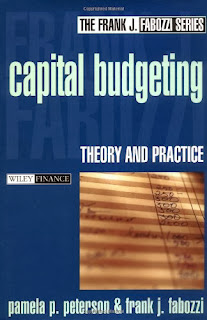Capital investment decisions are a constant challenge to all levels of financial managers. Capital Budgeting: Theory and Practice shows you how to confront them using state-of-the-art techniques.
Broken down into four comprehensive sections, Capital Budgeting: Theory and Practice explores and illustrates all aspects of the capital budgeting decision process. Pamela Peterson and Frank Fabozzi examine the critical issues and limitations of capital budgeting techniques with an in-depth analysis of:
Classifying capital budgeting proposals
Determining the relevant cash flows for capital budgeting proposals
Assessing the economic value of a capital budgeting proposal using different techniques
Incorporating risk into the capital budgeting decision
Evaluating whether to lease or borrow-to-buy
Capital Budgeting: Theory and Practice provides the knowledge, insight, and advice that will allow you to handle one of the most important aspects of your firm's financial management. Advanced enough for practitioners yet accessible enough for the novice, Capital Budgeting: Theory and Practice is your complete guide to understanding and benefiting from the essential techniques of capital budgeting.
From the Inside Flap
Corporate financial managers continually invest funds in assets, and these assets produce income and cash flows that the firm will then either reinvest in more assets or pay to the owners. Capital investment refers to a firm's investment in assets, and these investments may be either short-term or long-term in nature. A capital budgeting decision involves the long-term commitment of a firm's scarce resources. When such a decision is made, the firm is committed to a current and possibly future outlay of funds.
Capital budgeting decisions play a prominent role in determining whether a firm will be successful. The commitment of funds to a particular capital project can be enormous and may be irreversible. While some capital budgeting decisions are routine and don't change the course or risk of a firm, there are strategic capital budgeting decisions that will either have an impact on the firm's future market position in its current product lines or permit it to expand into a new product line. The annals of business history are replete with examples of how capital budgeting decisions have turned the tide for a company.
In Capital Budgeting: Theory and Practice, Pamela Peterson and Frank Fabozzi discuss and illustrate the capital budgeting decision process. In Section I ("Making Investment Decisions and Cash Flows"), they cover the stages of the capital budgeting process (investment screening and selection, capital budgeting proposal, budgeting approval and authorization, project tracking, and postcompletion audit), classification of investment projects, and the critical task of cash flow estimation.
In Section II, Peterson and Fabozzi cover the techniques for evaluating capital budgeting proposals and for selecting projects. These techniques include payback and discounted payback techniques, net present value technique, profitability index technique, internal rate of return technique, and modified internal rate of return technique. Section III clearly explains the critical task of incorporating risk into the capital budgeting decision.
In the final section, Peterson and Fabozzi explain a common capital budgeting decision: the decision to buy an asset with borrowed funds or lease the same asset. This is the classic "lease versus borrow-to-buy decision." The coverage includes valuing a lease, how to incorporate uncertainty into the lease valuation, and how a firm should analyze a lease if it's in a current tax-paying position or has an operating loss to carry forward.
Capital budgeting is one of the most important, and sometimes most difficult, parts of financing. Through expert advice and questions and problems at the end of each section, Capital Budgeting: Theory and Practice provides a detailed explanation of capital budgeting that will allow you to excel in this area.
Product Details :
- Series: Frank J. Fabozzi Series (Book 10)
- Hardcover: 243 pages
- Publisher: Wiley; 1 edition (February 2002)
- Language: English
- ISBN-10: 0471218332
- ISBN-13: 978-0471218333
- Product Dimensions: 0.9 x 6.1 x 9.2 inches
More Details about Capital Budgeting, 1st Edition

No comments:
Post a Comment